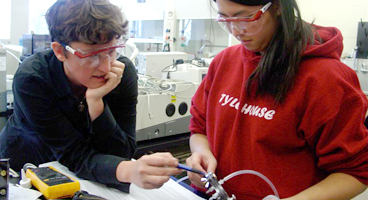Document Type
Article
Publication Date
1994
Publication Title
The Journal of the Acoustical Society of America
Abstract
The pressure reflectance R(ω) is the transfer function which may be defined for a linear one‐port network by the ratio of the reflected complex pressure divided by the incident complex pressure. The reflectance is a function that is closely related to the impedance of the 1‐port. The energy reflectance ℛ(ω) is defined as ‖R‖2. It represents the ratio of reflected to incident energy. In the human ear canal the energy reflectance is important because it is a measure of the inefficiency of the middle ear and cochlea, and because of the insight provided by its simple frequency domain interpretation. One may characterize the ear canal impedance by use of the pressure reflectance and its magnitude, sidestepping the difficult problems of (a) the unknown canal length from the measurement point to the eardrum, (b) the complicated geometry of the drum, and (c) the cross‐sectional area changes in the canal as a function of distance. Reported here are acoustic impedance measurements, looking into the ear canal, measured on ten young adults with normal hearing (ages 18–24).
The measurement point in the canal was approximately 0.85 cm from the entrance of the canal. From these measurements, the pressure reflectance in the canal is computed and impedance and reflectance measurements from 0.1 to 15.0 kHz are compared among ears. The average reflectance and the standard deviation of the reflectance for the ten subjects have been determined. The impedance and reflectance of two common ear simulators, the Brüel & Kjaer 4157 and the Industrial Research Products DB–100 (Zwislocki) coupler are also measured and compared to the average human measurements. All measurements are made using controls that assure a uniform accuracy in the acoustic calibration across subjects. This is done by the use of two standard acoustic resistors whose impedances are known. From the experimental results, it is concluded that there is significant subject variability in the magnitude of the reflectance for the ten ear canals. This variability is believed to be due to cochlear and middle ear impedance differences. An attempt was made at modeling the reflectance but, as discussed in the paper, several problems presently stand in the way of these models. Such models would be useful for acoustic virtual‐reality systems and for active noise control earphones.
Keywords
Electroacoustics, Active noise control, Hearing, Musical instruments, Auditory system, Acoustic impedance measurement, Acoustic phenomena, Optical properties
Volume
95
First Page
372
Last Page
384
DOI
10.1121/1.408329
Rights
© 1994 Acoustical Society of America.
Version
Version of Record
Recommended Citation
Voss, Susan E. and Allen, Jont B., "Measurement of Acoustic Impedance and Reflectance in the Human Ear Canal" (1994). Engineering: Faculty Publications, Smith College, Northampton, MA.
https://scholarworks.smith.edu/egr_facpubs/150


